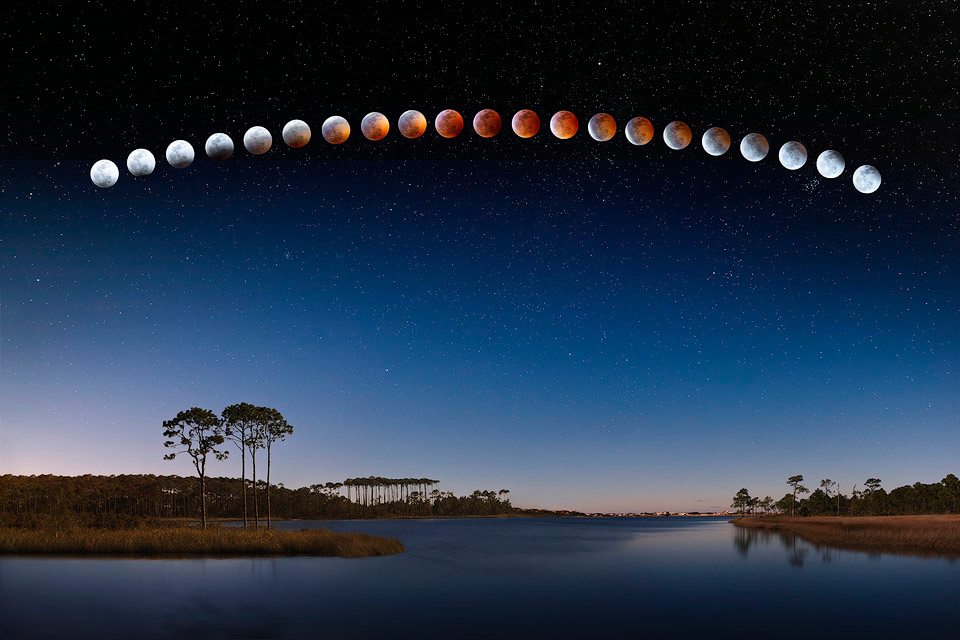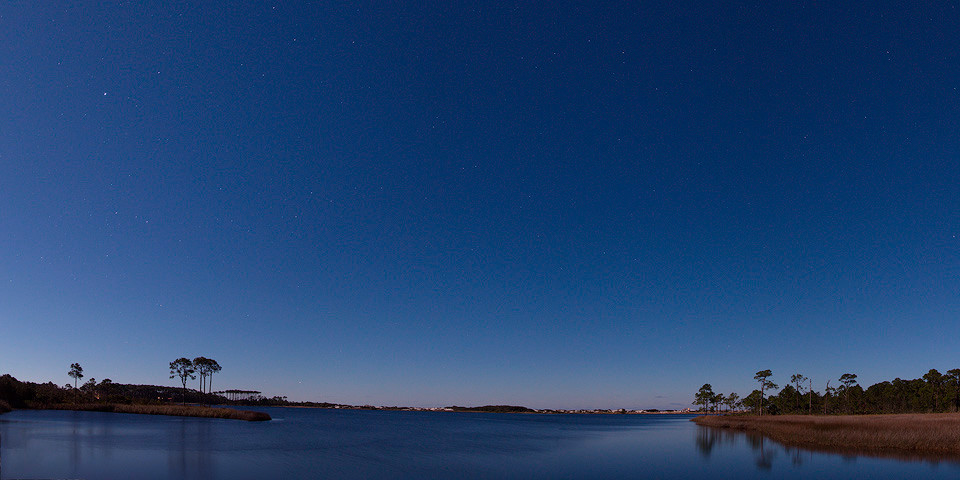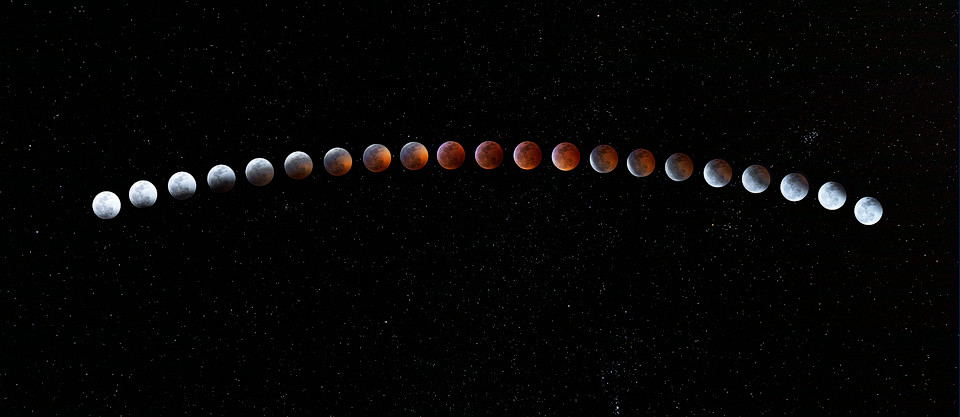Shooting the Lunar Eclipse!
Jan 27, 2019

Let me first start off by saying I always try to keep my pictures as close to "real" as possible, but I openly admit that in order to show a time lapse photo of the lunar eclipse I had to use a lot of in-camera and post-processing techniques .
Certainly not a trivial image to capture, the overall scene of Western Lake at Grayton Beach is comprised of 12 photos (6 across by 2 high) that span about 130 degrees horizontal FOV (field of view) and about 70 degree vertical FOV - all at 24mm. All of these photos were seamlessly stitched together to create one large panoramic image of the lake. I also took one more photo of the iconic tree line over the lake at 70mm that I used to focal length stack – Why? Because a 130 degree FOV pano, the trees are very tiny (see the image below) and have absolutely no visual impact. By stacking in the trees taken at 70mm brought the trees in closer (and larger) making it look more like what my eyes saw while standing there. Now you may be thinking that I did all of this during the eclipse – No, actually all of the lake photos were taken about 1.5 hours before the eclipse started while the moon was full and bright giving me plenty of natural light for the whole scene. Actually, it was so bright that I ended up darkening the lake photos in post to make it look more like a nighttime photo and therefore more natural.

The 12 shot photo of the lake before stacking in the 70mm photo of the trees on the left
Now here comes the fun part! For the next 3.5 hours I captured the 21 moon photos used to composite with the lake pano I took 1.5 hours prior. Before the eclipse started I set up my camera with a 400mm lens (on a tripod of course) so that I could capture closeup images of the moon with all of the beautiful crater details easily seen. After taking a few test shots to dial in my exposure, I hooked the camera up to a timer to take a photo of the moon every 10 minutes – actually, I took 2 exposures every 10 minutes to use for exposure blending during post. About a minute before each shot I repositioned my camera on the tripod to get the moon back in the frame – at 400mm it doesn’t take long for the moon to move out of the frame! Also, the difference in light radiating from the moon before the eclipse started and during the total eclipse is approximately x1000 (or 10 stops!), which means I was changing my exposure frequently between each shot! Doing all of this with the moon practically strait up in the sky wasn’t an easy task. Plus, it was cold (about 34F) and windy! I dressed about as warm as I know how, for a Florida boy! I was actually pretty warm… except for my feet! Too keep the circulation flowing to my feet- I paced about 100 yards back and forth between each shot – I must’ve paced 5 miles during the entire eclipse… I had worn a nice path in the sand after 3.5 hours!
There is one more photo I needed that is an important piece of the final image – one of the starry sky. While the moon was in the total eclipse the sky was extremely dark and the stars were really popping! I quickly switched over to my 14mm lens, opened up the aperture to f/2, and cranked up my ISO to 1250 to capture a really wide-angle photo of all those beautiful stars against that night sky. This is the photo that I used as a backdrop for the 21 moon photos in the final image.

21 moon photos stacked onto the Starry Sky Photo
Here’s a summary of the processing I used to create the final image.
- Moon & Sky Photo
- Blended each of the 21 moon photos – remember I took two photos for each moon shot,
- Processed the wide-angle starry sky shot (taken at 14mm).
- Layered each of the 21 moon photos on top of the starry sky shot
- Lake Photo
- Seamlessly stitched together the 12 photos to create the pano of the lake.
- Stacked the 70mm photo of the tree line onto the lake pano.
- Overall clean up of the final lake image
- Final image
- Stacked the Moon & Sky photo on top of the Lake photo – this process also added to the overall height of the final image.
- Carefully blended the transition zone between the two photos to appear seamless between the stars and the bluish sky of the lake photo.
- Made final touch-ups and color corrections to the final image.
- Finished! Whew!!!
One problem that this eclipse presented was that it was almost 80 degrees straight up in the sky making it very difficult to capture the moon and an earth-bound landscape (the lake) together - no mountains in Florida! However, through the process stacking the Moon & Sky shot on top of the lake pano added an additional 30 degrees (approx.) to the vertical FOV; therefore, there were no gaps (except in time) in any of the elements of the final image. In all, I used 56 images to create the final image.
Now is this something you would have seen if you were standing there? Well… kind of, except the moons would’ve appeared much higher in the sky,… as in, almost straight up! I tried to keep everything else as real and natural as possible. I could have chosen to give you only an image of the time-lapse of the eclipse against the sky, but my vision was to connect this heavenly phenomenon above to Mother Earth.
I spent 6 very cold hours at Grayton beach taking all of the photos necessary for this image, umpteen days during the prior weeks researching, planning, and visualizing this image; and I lost count how many hours spent processing it all! After all that work it was certainly nice to see it all come to fruition. I am grateful that Mother Nature blessed us with clear skies during the eclipse - I hope my capture did her justice.
I approached this photo as a challenge that I was looking forward to and, in the end, I enjoyed the experience immensely! I would love to hear your thoughts – please feel free to leave a comment.






